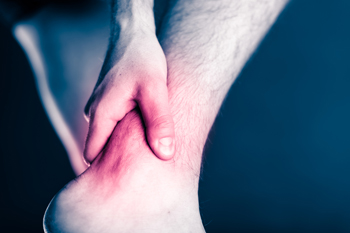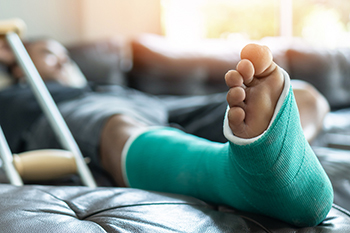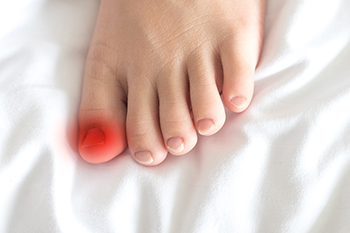Blog
Pickleball and Foot Injuries

Pickleball is one of the most popular sports people are playing now because it is slower and has a lower intensity compared to other sports. However, despite it seeming to be an easier form of exercise, injuries to all parts of the body can still be sustained. Ailments from pickleball related to the feet are commonly associated with the Achilles tendon and ankles. An Achilles strain involves the tendon in the back of the ankle that connects the calf to the heel. This can happen from the sudden stop-and-go actions in pickleball and can be accompanied by a sharp, snapping feeling. Ankle sprains are injuries to the ligaments on the side of the ankle and are typically caused by missteps or faulty landings. Wearing well-fitting and supportive footwear, warming up before playing pickleball, doing stretching and strengthening exercises regularly, and using ankle braces can help. If you get injured during pickleball or get another sports injury, it is important to rest. If pain persists or worsens, see a podiatrist as soon as possible to get a proper diagnosis and treatment plan so you can return to pain-free play.
Sports related foot and ankle injuries require proper treatment before players can go back to their regular routines. For more information, contact one of our podiatrists of James Kutchback, DPM, CWS-P. Our doctors can provide the care you need to keep you pain-free and on your feet.
Sports Related Foot and Ankle Injuries
Foot and ankle injuries are a common occurrence when it comes to athletes of any sport. While many athletes dismiss the initial aches and pains, the truth is that ignoring potential foot and ankle injuries can lead to serious problems. As athletes continue to place pressure and strain the area further, a mild injury can turn into something as serious as a rupture and may lead to a permanent disability. There are many factors that contribute to sports related foot and ankle injuries, which include failure to warm up properly, not providing support or wearing bad footwear. Common injuries and conditions athletes face, including:
- Plantar Fasciitis
- Achilles Tendinitis
- Achilles Tendon Rupture
- Ankle Sprains
Sports related injuries are commonly treated using the RICE method. This includes rest, applying ice to the injured area, compression and elevating the ankle. More serious sprains and injuries may require surgery, which could include arthroscopic and reconstructive surgery. Rehabilitation and therapy may also be required in order to get any recovering athlete to become fully functional again. Any unusual aches and pains an athlete sustains must be evaluated by a licensed, reputable medical professional.
If you have any questions please contact our offices located in The Woodlands and Woodville, TX . We offer the newest diagnostic and treatment technologies for all your foot and ankle needs.
Common Achilles Tendon Disorders

The Achilles tendon is a band of tissue that runs down the back of your leg and connects the calf muscle to the heel. Its main job is to lift the heel so you can walk, run, and jump. When the Achilles tendon is overused, it can result in either tendonitis or tendinosis. Achilles tendonitis is especially common among athletes, laborers who spend a lot of time on their feet, and people who exercise infrequently. Symptoms may consist of pain, tenderness, stiffness, or soreness at the back of the heel. Tendonitis is an inflammation usually caused by a sudden increase in repetitive activity and normally is short-lived once you cease the activity. If ignored or neglected, however, it can become Achilles tendonosis, a far more serious condition. This may result in minor tears that degenerate the tendon and can eventually cause it to rupture. If you believe you have injured your Achilles tendon, please consult with a podiatrist who can properly diagnose the severity of your condition and offer the appropriate treatment options.
Achilles tendon injuries need immediate attention to avoid future complications. If you have any concerns, contact one of our podiatrists of James Kutchback, DPM, CWS-P. Our doctors can provide the care you need to keep you pain-free and on your feet.
What Is the Achilles Tendon?
The Achilles tendon is a tendon that connects the lower leg muscles and calf to the heel of the foot. It is the strongest tendon in the human body and is essential for making movement possible. Because this tendon is such an integral part of the body, any injuries to it can create immense difficulties and should immediately be presented to a doctor.
What Are the Symptoms of an Achilles Tendon Injury?
There are various types of injuries that can affect the Achilles tendon. The two most common injuries are Achilles tendinitis and ruptures of the tendon.
Achilles Tendinitis Symptoms
- Inflammation
- Dull to severe pain
- Increased blood flow to the tendon
- Thickening of the tendon
Rupture Symptoms
- Extreme pain and swelling in the foot
- Total immobility
Treatment and Prevention
Achilles tendon injuries are diagnosed by a thorough physical evaluation, which can include an MRI. Treatment involves rest, physical therapy, and in some cases, surgery. However, various preventative measures can be taken to avoid these injuries, such as:
- Thorough stretching of the tendon before and after exercise
- Strengthening exercises like calf raises, squats, leg curls, leg extensions, leg raises, lunges, and leg presses
If you have any questions please feel free to contact our offices located in The Woodlands and Woodville, TX . We offer the newest diagnostic tools and technology to treat your foot and ankle needs.
Why Flip Flops Are Bad for Your Feet

Flip-flops are perfectly fine and actually quite helpful when used sparingly and for good reasons, such as to avoid wet surfaces in public showers, pool areas, and locker rooms, or getting to and from the beach without burning your feet on the hot sand. However, flip-flops do not offer an adequate structure for your feet and ankles, nor do they support your heels properly. Wearing them regularly can lead to fallen arches, heel pain, back issues, sore muscles, and more. They can even make you more prone to slipping and falling. To beat the heat in the summer months, it is better for your feet if you choose well-structured sandals, instead of flimsy flip-flops. For more information on the perils of flip-flops, contact a podiatrist.
Flip-flops are not always the best choice of footwear. If you have any concerns about your feet or ankles, contact one of our podiatrists from James Kutchback, DPM, CWS-P. Our doctors will assist you with all of your foot and ankle needs.
Flip-Flops and Feet
When the weather starts warming up, people enjoy wearing flip-flops. Flip-flops are comfortable, stylish, and easy to slip on and off; they're perfect for any summer beach goer. However, these shoes can cause harm to the feet.
How Can Flip-Flops Affect Me Long-Term?
- Ankle problems
- Hip problems
- Lower back problems
- Pain in the balls of the feet
- Problems with foot arches
- Changes in the way you walk
Are There Injuries Associated with Flip-Flops?
Yes. Since flip-flops are relatively weak and do not provide the same amount of support as sneakers, people who wear flip-flops regularly are more susceptible to injuries. On top of that, the open nature of the shoe makes your feet more prone to other problems, such as cuts and even infections. Common injuries and ailments include:
- Sprained ankles
- Blisters
- Infections
- Cuts and Scrapes
I like Wearing Flip-Flops. Are There Safe Alternatives?
When buying flip-flops, try to find ones that have sturdy soles and that are made of high-quality materials that will support for your feet. These flip-flops will cost more but will also last longer as a result.
If you have any questions, please feel free to contact our offices located in The Woodlands and Woodville, TX . We offer the newest diagnostic and treatment technologies for all your foot care needs.
Running Shoes Can Depend on Your Arch

There are many facets to buying the correct running shoe, and the most important one is how comfortable the fit is. One of the first things to understand is the term pronation, and what it means. It is defined as how the foot rolls from heel to toe as running occurs. Overpronation happens when the inside of the foot rolls too much to the inside, and this can happen if there is little or no arch. When the foot rolls excessively to the outside, this is referred to as underpronation, and can occur with a particularly high arch. It is beneficial to determine what type of arch you have before purchasing a pair of running shoes. This can be done by wetting your feet, and placing them on a paper bag. You will easily see which type of arch you have by performing this test. There are several types of running shoes, including motion control shoes, stability shoes, and neutral cushioning shoes. It is suggested that you consult with a podiatrist who can determine what the best type of running shoe is for you.
You should always make sure your running shoes fit properly in order to avoid injury. For more information, contact one of our podiatrists from James Kutchback, DPM, CWS-P. Our doctors can provide the care you need to keep you pain-free and on your feet.
Choosing the Right Running Shoe for Your Foot Type
Improper shoe sizing can cause a myriad of problems for your feet. Shoes that don’t fit you properly can lead to muscular imbalances in your body, which can result in foot, knee, and hip injuries.
Tips for Finding the Right Running Shoe
- Make sure you have a thumb’s width of wiggle room between the end of your longest toe and the front of the shoe.
- There should be little to no slipping at the heel
- Don’t assume your size in one shoe brand will be your size in another
- Do not lace up your shoes too tightly
- Walk around in the store with your new shoes before you buy them
If you have any questions, please feel free to contact our offices located in The Woodlands and Woodville, TX . We offer the newest diagnostic and treatment technologies for all your foot care needs.
Ankle Fractures in Children

An ankle fracture in children involves at least one bone break in your child’s ankle. Common symptoms of an ankle fracture include pain, tenderness, swelling, bruising, and trouble moving or putting weight on the ankle or foot. This type of injury is diagnosed with an X-ray, ultrasound, CT, or MRI. A podiatrist will usually treat a child’s ankle break with a supportive device, such as a cast or brace, and crutches are often provided to help keep weight off the affected ankle. If the fracture is severe, surgery may be needed. Resting the ankle, applying ice, compressing, and elevating the ankle should all help in healing. If you think your child has a broken ankle, it is suggested you visit a podiatrist for proper diagnosis and a treatment plan that best suits your child’s injury.
Broken ankles need immediate treatment. If you are seeking treatment, contact one of our podiatrists from James Kutchback, DPM, CWS-P. Our doctors can provide the care you need to keep you pain-free and on your feet.
Broken Ankles
A broken ankle is experienced when a person fractures their tibia or fibula in the lower leg and ankle area. Both of these bones are attached at the bottom of the leg and combine to form what we know to be our ankle.
When a physician is referring to a break of the ankle, he or she is usually referring to a break in the area where the tibia and fibula are joined to create our ankle joint. Ankles are more prone to fractures because the ankle is an area that suffers a lot of pressure and stress. There are some obvious signs when a person experiences a fractured ankle, and the following symptoms may be present.
Symptoms of a Fractured Ankle
- Excessive pain when the area is touched or when any pressure is placed on the ankle
- Swelling around the area
- Bruising of the area
- Area appears to be deformed
If you suspect an ankle fracture, it is recommended to seek treatment as soon as possible. The sooner you have your podiatrist diagnose the fracture, the quicker you’ll be on the way towards recovery.
If you have any questions, please feel free to contact our offices located in The Woodlands and Woodville, TX . We offer the newest diagnostic and treatment technologies for all your foot care needs.
Specific Reasons Why an Ingrown Toenail Can Develop

The foot condition known as ingrown toenails can be extremely uncomfortable. It is defined as a toenail that grows into the surrounding skin and can develop from wearing shoes that do not fit correctly. Additional reasons why ingrown toenails may occur include trimming the toenails improperly and sustaining a toe injury. It is relatively easy to see if an ingrown toenail has developed. The surrounding skin of the affected toenail will appear red and there can be a discharge that comes from it. The nail will generally feel better when it is soaked in warm water. This can also make it easier to gently pull the nail away from the skin. This is just a temporary fix, however, it is strongly suggested that you are under the care of a podiatrist who can provide professional care for recurring and infected ingrown toenails.
Ingrown toenails can become painful if they are not treated properly. For more information about ingrown toenails, contact one of our podiatrists of James Kutchback, DPM, CWS-P. Our doctors can provide the care you need to keep you pain-free and on your feet.
Ingrown Toenails
Ingrown toenails occur when a toenail grows sideways into the bed of the nail, causing pain, swelling, and possibly infection.
Causes
- Bacterial infections
- Improper nail cutting such as cutting it too short or not straight across
- Trauma to the toe, such as stubbing, which causes the nail to grow back irregularly
- Ill-fitting shoes that bunch the toes too close together
- Genetic predisposition
Prevention
Because ingrown toenails are not something found outside of shoe-wearing cultures, going barefoot as often as possible will decrease the likeliness of developing ingrown toenails. Wearing proper fitting shoes and using proper cutting techniques will also help decrease your risk of developing ingrown toenails.
Treatment
Ingrown toenails are a very treatable foot condition. In minor cases, soaking the affected area in salt or antibacterial soaps will not only help with the ingrown nail itself, but also help prevent any infections from occurring. In more severe cases, surgery is an option. In either case, speaking to your podiatrist about this condition will help you get a better understanding of specific treatment options that are right for you.
If you have any questions, please feel free to contact our offices located in The Woodlands and Woodville, TX . We offer the newest diagnostic and treatment technologies for all your foot care needs.
No Matter What You Call It, Plantar Fasciitis Hurts

The plantar fascia is a connective band of tissue linking the heel with the toes. Since it is located on the bottom of the foot and is constantly used while standing, walking, running, and jumping, it may become torn, irritated, and swollen from overuse. The medical term for this condition is plantar fasciitis and it is the most common form of heel pain. Pain from plantar fasciitis is usually at its worst first thing in the morning after the plantar fascia has tightened overnight. After walking around and warming the body up, the pain typically subsides only to return later in the day. Because it can be caused by walking, running, and doing repetitive movements, plantar fasciitis has been nicknamed policeman’s heel, runner’s heel, and tennis heel. People who are elderly, obese, or work on their feet all day are more susceptible to acquiring this condition. Additionally, people who have high arches, flat fleet, or certain medical conditions are more at risk. Podiatrists have extensive experience and several effective methods for treating plantar fasciitis because it is so common. If you believe you have this condition, it is advised to make an appointment with a podiatrist who can provide a proper diagnosis, followed by starting correct treatment techniques.
Plantar fasciitis can be very painful and inconvenient. If you are experiencing heel pain or symptoms of plantar fasciitis, contact one of our podiatrists from James Kutchback, DPM, CWS-P. Our doctors can provide the care you need to keep you pain-free and on your feet.
What Is Plantar Fasciitis?
Plantar fasciitis is the inflammation of the thick band of tissue that runs along the bottom of your foot, known as the plantar fascia, and causes mild to severe heel pain.
What Causes Plantar Fasciitis?
- Excessive running
- Non-supportive shoes
- Overpronation
- Repeated stretching and tearing of the plantar fascia
How Can It Be Treated?
- Conservative measures – anti-inflammatories, ice packs, stretching exercises, physical therapy, orthotic devices
- Shockwave therapy – sound waves are sent to the affected area to facilitate healing and are usually used for chronic cases of plantar fasciitis
- Surgery – usually only used as a last resort when all else fails. The plantar fascia can be surgically detached from the heel
While very treatable, plantar fasciitis is definitely not something that should be ignored. Especially in severe cases, speaking to your doctor right away is highly recommended to avoid complications and severe heel pain. Your podiatrist can work with you to provide the appropriate treatment options tailored to your condition.
If you have any questions, please feel free to contact our offices located in The Woodlands and Woodville, TX . We offer the newest diagnostic and treatment technologies for all your foot care needs.






